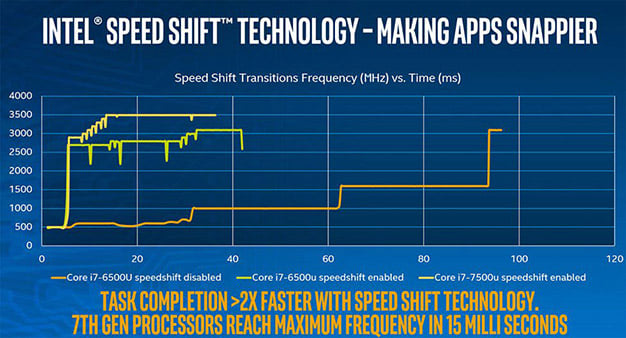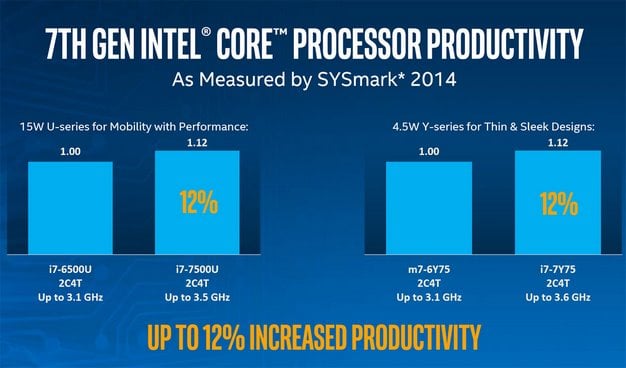Intel Kaby Lake 7th Gen Core Series: Higher Perf-Per-Watt, Enhanced Media Engine
Intel Kaby Lake Performance
We haven’t had a chance to run an independent suite of benchmarks on a Kaby Lake-based system just yet, but Intel has provided some baseline numbers to set expectations. Although the core architecture is based on Skylake, the aggregate effect of the improvements to Speed Shift, higher frequencies, and new multimedia engine capabilities, should result in a significantly improved user experience over a variety of workloads.
Thanks to some additional granularity and faster switching, Kaby Lake-based core processors are able to change power states more quickly than Skylake. Using the latest build of Windows Redstone, Kaby Lake is able to make Speed Shift transitions measurably faster, which allows the processor to ramp up clocks speeds on more taxing workloads, more quickly. According to Intel, Kaby Lake based processors can hit their maximum frequency in only 15ms.
We’ve also got some system and web-level benchmarks comparing 15W Skylake-based Core i7-6500U and Kaby Lake-based Core i7-7500U U-Series processors, and Core m7-6Y75 (Skylake) and Core i7-7Y75 (Kaby Lake) 4.5W Y-Series processors. According to Sysmark 2014, Kaby Lake processors are up to 12% faster, whereas WebXPRT 2015 shows Kaby Lake with 19% (U-Series) and 18% (Y-Series) advantages over the previous generation.
Thanks to new capabilities in the Kaby Lake’s multimedia engine, 7th Gen Core processors are also far more efficient when processing 4K HEVC 10-bit and VP9 workloads. The comparisons above pit a Skylake-based Core i7-6500U and Kaby Lake-based Core i7-7500U against each other with local 4K HEVC 10-bit content and a 4K VP9 stream from YouTube playing in Chrome. According to the data provided by Intel, Kaby Lake-based processors use far less power and consume far fewer CPU resources processing this video workload. The net effect of these improvements are either longer battery life in mobile devices or a better multi-tasking experience when playing either media type while also running other applications.
Thanks to some additional granularity and faster switching, Kaby Lake-based core processors are able to change power states more quickly than Skylake. Using the latest build of Windows Redstone, Kaby Lake is able to make Speed Shift transitions measurably faster, which allows the processor to ramp up clocks speeds on more taxing workloads, more quickly. According to Intel, Kaby Lake based processors can hit their maximum frequency in only 15ms.
We’ve also got some system and web-level benchmarks comparing 15W Skylake-based Core i7-6500U and Kaby Lake-based Core i7-7500U U-Series processors, and Core m7-6Y75 (Skylake) and Core i7-7Y75 (Kaby Lake) 4.5W Y-Series processors. According to Sysmark 2014, Kaby Lake processors are up to 12% faster, whereas WebXPRT 2015 shows Kaby Lake with 19% (U-Series) and 18% (Y-Series) advantages over the previous generation.
Thanks to new capabilities in the Kaby Lake’s multimedia engine, 7th Gen Core processors are also far more efficient when processing 4K HEVC 10-bit and VP9 workloads. The comparisons above pit a Skylake-based Core i7-6500U and Kaby Lake-based Core i7-7500U against each other with local 4K HEVC 10-bit content and a 4K VP9 stream from YouTube playing in Chrome. According to the data provided by Intel, Kaby Lake-based processors use far less power and consume far fewer CPU resources processing this video workload. The net effect of these improvements are either longer battery life in mobile devices or a better multi-tasking experience when playing either media type while also running other applications.











